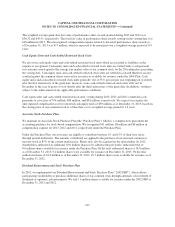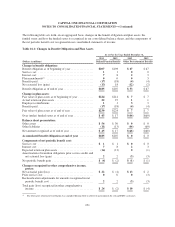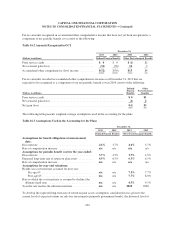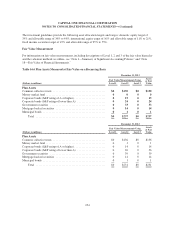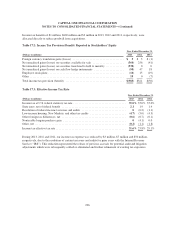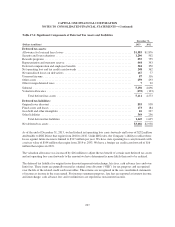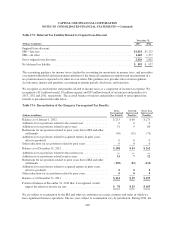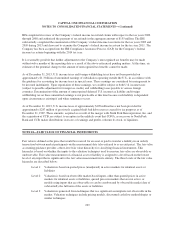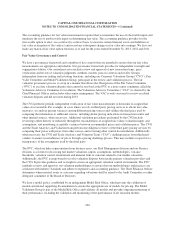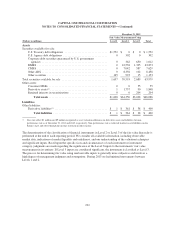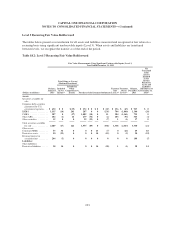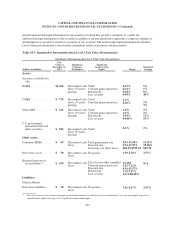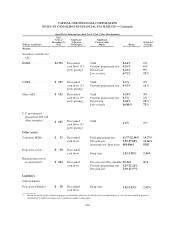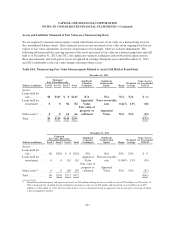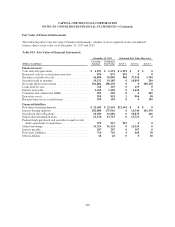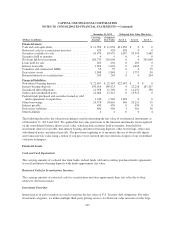Capital One 2013 Annual Report Download - page 249
Download and view the complete annual report
Please find page 249 of the 2013 Capital One annual report below. You can navigate through the pages in the report by either clicking on the pages listed below, or by using the keyword search tool below to find specific information within the annual report.
CAPITAL ONE FINANCIAL CORPORATION
NOTES TO CONSOLIDATED FINANCIAL STATEMENTS—(Continued)
IRS completed its review of the Company’s federal income tax refund claims with respect to the tax years 2000
through 2008 and authorized the payment of tax refunds in the aggregate amount of $155 million. The IRS
substantially completed the examination of the Company’s federal income tax returns for the tax years 2009 and
2010 during 2013 and chose not to examine the Company’s federal income tax return for the tax year 2011. The
Company has been accepted into the IRS Compliance Assurance Process (CAP) for the Company’s federal
income tax returns beginning with the 2014 tax year.
It is reasonably possible that further adjustments to the Company’s unrecognized tax benefits may be made
within twelve months of the reporting date as a result of the above-referenced pending matters. At this time, an
estimate of the potential change to the amount of unrecognized tax benefits cannot be made.
As of December 31, 2013, U.S. income taxes and foreign withholding taxes have not been provided on
approximately $1.3 billion of unremitted earnings of subsidiaries operating outside the U.S., in accordance with
the guidance for accounting for income taxes in special areas. These earnings are considered by management to
be invested indefinitely. Upon repatriation of these earnings, we could be subject to both U.S. income taxes
(subject to possible adjustment for foreign tax credits) and withholding taxes payable to various foreign
countries. Determination of the amount of unrecognized deferred U.S. income tax liability and foreign
withholding tax on these unremitted earnings is not practicable at this time because such liability is dependent
upon circumstances existing if and when remittance occurs.
As of December 31, 2013, U.S. income taxes of approximately $109 million have not been provided for
approximately $287 million of previously acquired thrift bad debt reserves created for tax purposes as of
December 31, 1987. These amounts, acquired as a result of the merger with North Fork Bancorporation, Inc. and
the acquisition of CCB, are subject to recapture in the unlikely event that CONA, as successor to North Fork
Bank and CCB, makes distributions in excess of earnings and profits, redeems its stock, or liquidates.
NOTE 18—FAIR VALUE OF FINANCIAL INSTRUMENTS
Fair value is defined as the price that would be received for an asset or paid to transfer a liability in an orderly
transaction between market participants on the measurement date (also referred to as an exit price). The fair value
accounting guidance provides a three-level fair value hierarchy for classifying financial instruments. This
hierarchy is based on whether the inputs to the valuation techniques used to measure fair value are observable or
unobservable. Fair value measurement of a financial asset or liability is assigned to a level based on the lowest
level of any input that is significant to the fair value measurement in its entirety. The three levels of the fair value
hierarchy are described below:
Level 1: Valuation is based on quoted prices (unadjusted) in active markets for identical assets or
liabilities
Level 2: Valuation is based on observable market-based inputs, other than quoted prices in active
markets for identical assets or liabilities, quoted prices in markets that are not active, or
models using inputs that are observable or can be corroborated by observable market data of
substantially the full term of the assets or liabilities
Level 3: Valuation is generated from techniques that use significant assumptions not observable in the
market. Valuation techniques include pricing models, discounted cash flow methodologies or
similar techniques.
229


